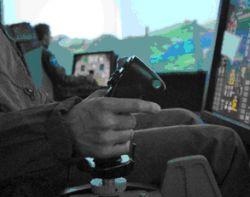The National Aerospace Laboratory (NLR) is working to develop computer generated opponents as part of a four-year project called ‘Smart Bandits’. NLR’s efforts are focused on providing these virtual opponents with more ‘intelligence’, thereby rendering fighter pilot training exercises against virtual enemies more realistically. The purpose for these ‘smart bandits’ is to serve as fully fledged training opponents in various military training scenarios.
Such smart bandits are examples of intelligent ‘Computer Generated Forces’ (CGFs). NLR will develop these CGFs in such a way that they can be demonstrated in simulators, such as the Fighter 4-Ship, which will allow for research and improvement of formation-based mission training .The CFGs will be integrated in a so called scenario management software package, from which the behaviour of all CGFs (enemies, supporting forces, ground threats, etc) will be managed.
Ultimately, the Dutch Ministry of Defense, which commissioned this research, will use the smart bandits in its simulators as part of tactical flight training exercises. In the longer term, the smart bandits will also be used in Live, Virtual, Constructive (LVC) exercises, which combines simulation training with live training using actual platforms.
The ‘Smart Bandits’ project started this year. NLR will receive 1.5 million euro from the Ministry of Defense over the next four years to execute the project. Researchers from VU University Amsterdam’s ‘Agent System Group’ are also involved in the project, focusing on modelling human aspects of the smart bandits. In addition, NLR has appointed a PhD researcher who will conduct research in this field. Also, the US Air Force Research Laboratory (AFRL) is collaborating in this project: a USAF specialist will join the NLR in delving deeper into this research field and contribute to the knowledge exchange between both laboratories. As a result, these intelligent CGFs will ultimately not only be able to make tactical decisions but should also be able to show human behaviour mediated by fear, tiredness and preconceptions.
NLR’s research efforts are particularly focused on the required functions of the smart bandits and their effective integration in mission simulation. How do these smart bandits appear on the various displays in the cockpit? How will they manoeuvre when they attack of defend themselves? What intelligence level is required? The current research schedule calls for a working prototype with limited functionality to be developed in the first year of the project. This prototype will be run on the Fighter 4-Ship.



